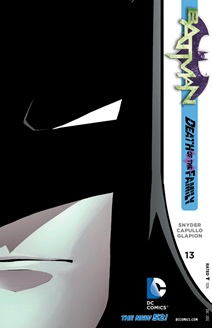 Ask any fan of Batman comics who they think the Dark Knight’s greatest nemesis is, and you’ll be sure to hear The Joker’s name more than once. The quintessential Batman villain, The Joker has always been the other side of the same coin, a product of similar tragedy that turned him into a murderous madman. So when it was announced that Scott Snyder and Greg Capullo were bringing a new story featuring The Joker, especially on the heels of his fantastic character study of Bruce Wayne in his previous arc “The Court of Owls”, it wasn’t hard to be intrigued.
Ask any fan of Batman comics who they think the Dark Knight’s greatest nemesis is, and you’ll be sure to hear The Joker’s name more than once. The quintessential Batman villain, The Joker has always been the other side of the same coin, a product of similar tragedy that turned him into a murderous madman. So when it was announced that Scott Snyder and Greg Capullo were bringing a new story featuring The Joker, especially on the heels of his fantastic character study of Bruce Wayne in his previous arc “The Court of Owls”, it wasn’t hard to be intrigued.
The stage for Batman #13, which marks the beginning of his new story arc “Death of the Family”, takes place a year after the events of Detective Comics #1. The Joker had allowed his face to be removed by another villain known as The Dollmaker, and he returns a year later beginning a series of ‘greatest hits’ – previous crimes that were perpetrated in famous Batman stories of the past. As we soon learn though, his motives are much more sinister. These events don’t end up as Bruce expects, and it hurtles towards a fantastic cliff-hanger at the issue’s end.
Snyder creates a wonderfully dark entrance for the Clown Prince. The inner monologue of the Batman, combined with his uncanny ability to channel The Joker’s demented dialogue to a tee, helps create a truly dark and twisted story. Snyder manages to instil a true sense of dread and horror within the pages of Batman #13, especially in a chilling assault of the Gotham P.D. at the onset of the issue. The horror isn’t merely blood and gore either, as the Joker’s dialogue throughout the sequence is truly evil and terrifying. Without spoiling anything, you’re going to want to look under your bed. While many of the stunts resemble fairly “standard” (whatever that term may mean in this case) Joker crimes, it sets the mood for how the arc will play out, and still leaves the reader guessing where the action will end up next.
Synder also works in a subtle character moment for the Dark Knight in this issue. As he communicates with the rest of the Bat-family about The Joker’s return, you learn that he intends to keep details, and even the investigation itself, between him and his nemesis. It is a moment where you realise that Bruce either wants to protect the ones he loves, or is willing to bank on his own skills and hubris to bring The Joker down, which is an important theme tackled in the “The Court of Owls” arc. It’s interesting that Snyder chose to revisit this theme, considering that Bruce Wayne should have learned his lesson in “The Court of Owls”, and it will be interesting to see how it will play out.
Greg Capullo’s pencils combined with Jonathan Glapion’s colours gives the art in the issue a strong resemblance to the Batman: The Animated Series of the late 1990s. It’s suitably graphic without relying too much on gore, and when The Joker’s face is finally revealed, it will give you chills down your spine. Its dark and twisted, and it really works.
It should also be worth mentioning that picking up Batman #13 without any previous interaction with Snyder’s run will be of no real detriment to the story he is writing here. While it may drop in a couple of references to his previous encounters with The Joker, it only requires a base understanding of how the villain works.
When Scott Snyder’s run on Batman moved towards the event “Death of the Family”, and the inevitable return of the Clown Prince of Gotham, the questions were asked regarding whether this new take on this villain would live up to the standard set by The Killing Joke, and other Joker tales of times gone by. After Batman #13 perhaps we should begin to ask a new question:
What if the “Death of the Family” is better?


Recent Comments